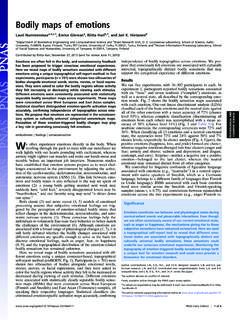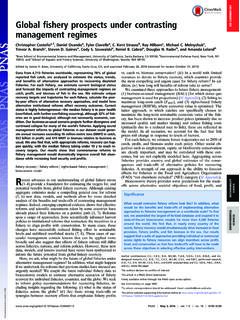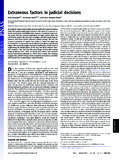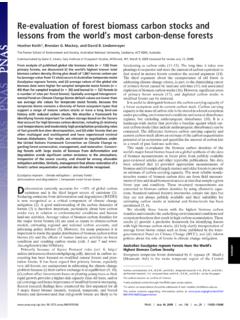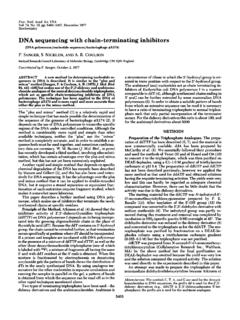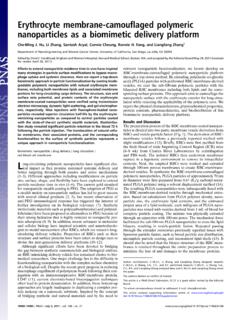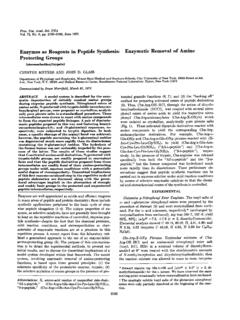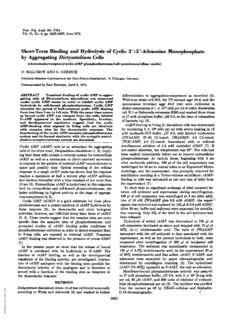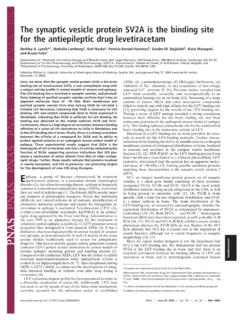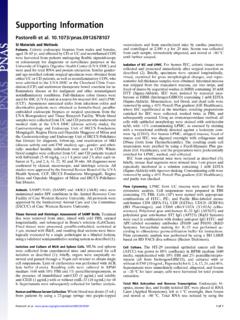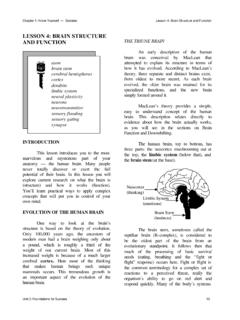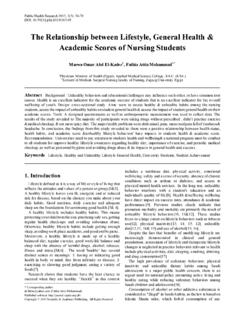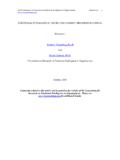Transcription of The difference of being human: Morality - pnas.org
1 The difference of being human: Morality Francisco J. Ayala1. Department of Ecology and Evolutionary Biology, University of California, Irvine, CA 92697. In The Descent of Man, and Selection in Relation to Sex, published they may be the most obvious. Other notable anatomical dif- in 1871, Charles Darwin wrote: I fully .. subscribe to the judg- ferences include the reduction of the size of the jaws and teeth ment of those writers who maintain that of all the differences and the remodeling of the face; reduction of body hair and between man and the lower animals the moral sense or conscience changes in the skin and skin glands; modi cation of the vocal is by far the most important.
2 I raise the question of whether tract and larynx, with important implications for spoken lan- Morality is biologically or culturally determined. The question of guage; opposing thumbs that allow precise manipulation of whether the moral sense is biologically determined may refer ei- objects; and cryptic ovulation, which may have been associated ther to the capacity for ethics ( , the proclivity to judge human with the evolution of the nuclear family, consisting of one mother actions as either right or wrong), or to the moral norms accepted and one father with their children. by human beings for guiding their actions.
3 I propose that the Humans are notably different from the apes and all other capacity for ethics is a necessary attribute of human nature, animals in anatomy, but also and no less importantly in their whereas moral codes are products of cultural evolution. Humans functional capacities and behavior, both as individuals and so- have a moral sense because their biological makeup determines cially. Most fundamental are the advanced intellectual faculties, the presence of three necessary conditions for ethical behavior: (i) which allow humans to categorize (see individual objects as the ability to anticipate the consequences of one's own actions; (ii) members of general classes), think in the abstract and form the ability to make value judgments; and (iii) the ability to choose images of realities that are not present (and, thus, anticipate between alternative courses of action.)
4 Ethical behavior came future events and planning future actions), and reason. Other about in evolution not because it is adaptive in itself but as a nec- distinctive functional features are self-awareness and death essary consequence of man's eminent intellectual abilities, which awareness; symbolic (creative) language; tool making and tech- are an attribute directly promoted by natural selection. That is, nology; complex and extremely variable forms of cooperation Morality evolved as an exaptation, not as an adaptation. Moral and social organization; legal codes and political institutions.
5 Codes, however, are outcomes of cultural evolution, which science, literature, and art; and ethics and religion (3). accounts for the diversity of cultural norms among populations Humans live in groups that are socially organized, and so do and for their evolution through time. other primates. But primate societies do not approach the complexity of human social organization. A distinctive human |. biological evolution cultural evolution | human uniqueness | moral social trait is culture, which may be understood here as the set of |. norms moral sense non strictly biological human activities and creations.
6 Culture in this sense includes social and political institutions, ways of doing H umans are animals and have evolved from ancestors that were not human. But our bodily frame, as well as the capacities that stem from it, show also that we are a unique kind of animal, things, religious and ethical traditions, language, common sense and scienti c knowledge, art and literature, technology, and in general all of the creations of the human mind. Culture is a pool a unique kind of ape, with distinctive features, of which the moral of technological and social innovations that people accumulate sense is one and, if we are to agree with Darwin, the most im- to help them live their lives (ref.)
7 4, p. 65). The advent of culture portant one (ref. 1, p. 67). As Steven Pinker has written, Morality has brought with it cultural evolution, a superorganic mode of is not just any old topic in psychology but close to our conception evolution superimposed on the organic mode, which has, in the of the meaning of life. Moral goodness is what gives each of us the last few millennia, become the dominant mode of human evo- sense that we are worthy human beings (ref. 2, p. 34). In this lution. Cultural evolution has come about because of cultural essay, I will examine Morality as a consequential attribute among change and inheritance, a distinctively human mode of achieving those that determine the difference of being human.
8 At issue, of adaptation to the environment and transmitting it through the course, stands the evolutionary origin of Morality . generations (3, 5 9). Human Uniqueness Moral Behavior Two conspicuous human anatomical traits are erect posture and I will de ne moral behavior for the present purposes as the large brain. We are the only vertebrate species with a bipedal gait actions of a person who takes into account in a sympathetic way and erect posture; birds are bipedal, but their backbone stands the impact the actions have on others. A similar de nition is horizontal rather than vertical (penguins are a trivial exception) advanced, for example, by David Copp in The Oxford Handbook and the bipedalism of kangaroos lacks erect posture and is of Ethical Theory (ref.)
9 10, p. 4): [W]e can take a person's moral drastically different from our own. Erect posture and bipedal gait beliefs to be the beliefs she has about how to live her life when entail other morphological changes in the backbone, hipbone, and feet and others. Brain size in mammals is generally proportional to body size. This paper results from the Arthur M. Sackler Colloquium of the National Academy of Sciences, In the Light of Evolution IV: The Human Condition, held December 10 12, Relative to body mass, humans have the largest brain. The 2009, at the Arnold and Mabel Beckman Center of the National Academies of Sciences chimpanzee brain has an approximate volume of 300 cm3; and Engineering in Irvine, CA.
10 The complete program and audio les of most presentations a gorilla's is slightly larger. The human adult brain is more than are available on the NAS Web site at three times larger, typically between 1,300 cm3 and 1,400 cm3. In this essay, the author draws extensively from his work, What the Biological Sciences The brain is not only larger in humans than in apes but also much Can and Cannot Contribute to Ethics, chap. 18, pp. 316 336, in Ayala FJ and Arp R, eds. Contemporary Debates in Philosophy of Biology (Wiley-Blackwell, Malden, MA, 2010). more complex. The cerebral cortex, where the higher cognitive functions are processed, is in humans proportionally much Author contributions: wrote the paper.
